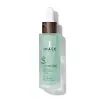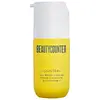What's inside
What's inside
 Key Ingredients
Key Ingredients

 Benefits
Benefits

 Concerns
Concerns

 Ingredients Side-by-side
Ingredients Side-by-side

Water
Skin ConditioningAloe Barbadensis Leaf Juice
Skin ConditioningGlycerin
HumectantPropanediol
SolventVitis Vinifera Fruit Water
Skin ConditioningPolysorbate 20
EmulsifyingPhenoxyethanol
PreservativeBeta Vulgaris Root Extract
Skin ConditioningCaprylyl Glycol
EmollientPolyacrylate Crosspolymer-6
Emulsion StabilisingHydroxyethyl Acrylate/Sodium Acryloyldimethyl Taurate Copolymer
Emulsion StabilisingCitrus Aurantium Dulcis Peel Oil
MaskingLimonene
PerfumingSodium Hyaluronate
HumectantAminomethyl Propanol
BufferingCopper PCA
HumectantEthylhexylglycerin
Skin ConditioningGlycine
BufferingNiacinamide
SmoothingLactic Acid
BufferingCitric Acid
BufferingPolysorbate 60
EmulsifyingSorbitan Isostearate
EmulsifyingArctium Lappa Root Extract
Skin ConditioningCalendula Officinalis Flower Extract
MaskingCamellia Sinensis Leaf Extract
AntimicrobialCitrus Nobilis Peel Oil
MaskingCitrus Paradisi Peel Oil
MaskingCurcuma Longa Root Extract
MaskingNelumbo Nucifera Flower Extract
Skin ConditioningTamarindus Indica Fruit Extract
Skin ConditioningTerminalia Ferdinandiana Fruit Extract
AntioxidantTrifolium Pratense Flower Extract
AstringentBiosaccharide Gum-1
HumectantHaberlea Rhodopensis Leaf Extract
Skin ConditioningYeast Extract
Skin ConditioningLevulinic Acid
PerfumingP-Anisic Acid
MaskingSodium Hydroxide
BufferingGlyceryl Caprylate
EmollientVanilla Planifolia Fruit Extract
Skin ConditioningTocopherol
AntioxidantPectin
Emulsion StabilisingWater, Aloe Barbadensis Leaf Juice, Glycerin, Propanediol, Vitis Vinifera Fruit Water, Polysorbate 20, Phenoxyethanol, Beta Vulgaris Root Extract, Caprylyl Glycol, Polyacrylate Crosspolymer-6, Hydroxyethyl Acrylate/Sodium Acryloyldimethyl Taurate Copolymer, Citrus Aurantium Dulcis Peel Oil, Limonene, Sodium Hyaluronate, Aminomethyl Propanol, Copper PCA, Ethylhexylglycerin, Glycine, Niacinamide, Lactic Acid, Citric Acid, Polysorbate 60, Sorbitan Isostearate, Arctium Lappa Root Extract, Calendula Officinalis Flower Extract, Camellia Sinensis Leaf Extract, Citrus Nobilis Peel Oil, Citrus Paradisi Peel Oil, Curcuma Longa Root Extract, Nelumbo Nucifera Flower Extract, Tamarindus Indica Fruit Extract, Terminalia Ferdinandiana Fruit Extract, Trifolium Pratense Flower Extract, Biosaccharide Gum-1, Haberlea Rhodopensis Leaf Extract, Yeast Extract, Levulinic Acid, P-Anisic Acid, Sodium Hydroxide, Glyceryl Caprylate, Vanilla Planifolia Fruit Extract, Tocopherol, Pectin
Water
Skin ConditioningPropanediol
SolventBis-Glyceryl Ascorbate
AntioxidantTetrahexyldecyl Ascorbate
AntioxidantPentylene Glycol
Skin ConditioningCoconut Alkanes
EmollientGlycerin
HumectantHydroxyethyl Acrylate/Sodium Acryloyldimethyl Taurate Copolymer
Emulsion StabilisingCurcuma Longa Root Extract
MaskingMyrciaria Dubia Fruit Extract
Skin ConditioningCurcumin
AntioxidantSodium Hyaluronate
HumectantPrunus Amygdalus Dulcis Oil
Skin ConditioningPhytic Acid
Citrus Aurantium Bergamia Fruit Oil
MaskingCoco-Caprylate/Caprate
EmollientPolyglyceryl-6 Polyricinoleate
EmulsifyingCitrus Nobilis Peel Oil
MaskingCitrus Aurantium Dulcis Flower Oil
AstringentEthylhexylglycerin
Skin ConditioningPotassium Sorbate
PreservativePhenoxyethanol
PreservativeDecanal
MaskingCitrus Aurantium Dulcis Peel Oil
MaskingIonone
AstringentEthyl Lactate
PerfumingVanillin
MaskingIsoamyl Acetate
SolventEthyl 2-Methylbutyrate
PerfumingMethoxyphenylbutanone
PerfumingOxacycloheptadec-10-En-2-One
PerfumingDimethylhydroxy Furanone
MaskingEthyl Propionate
PerfumingEthyl Cinnamate
PerfumingHexenyl Acetate
MaskingTriethyl Citrate
MaskingBenzyl Acetate
MaskingEthyl Acetate
PerfumingCitral
PerfumingLimonene
PerfumingLinalool
PerfumingWater, Propanediol, Bis-Glyceryl Ascorbate, Tetrahexyldecyl Ascorbate, Pentylene Glycol, Coconut Alkanes, Glycerin, Hydroxyethyl Acrylate/Sodium Acryloyldimethyl Taurate Copolymer, Curcuma Longa Root Extract, Myrciaria Dubia Fruit Extract, Curcumin, Sodium Hyaluronate, Prunus Amygdalus Dulcis Oil, Phytic Acid, Citrus Aurantium Bergamia Fruit Oil, Coco-Caprylate/Caprate, Polyglyceryl-6 Polyricinoleate, Citrus Nobilis Peel Oil, Citrus Aurantium Dulcis Flower Oil, Ethylhexylglycerin, Potassium Sorbate, Phenoxyethanol, Decanal, Citrus Aurantium Dulcis Peel Oil, Ionone, Ethyl Lactate, Vanillin, Isoamyl Acetate, Ethyl 2-Methylbutyrate, Methoxyphenylbutanone, Oxacycloheptadec-10-En-2-One, Dimethylhydroxy Furanone, Ethyl Propionate, Ethyl Cinnamate, Hexenyl Acetate, Triethyl Citrate, Benzyl Acetate, Ethyl Acetate, Citral, Limonene, Linalool
 Reviews
Reviews

Ingredients Explained
These ingredients are found in both products.
Ingredients higher up in an ingredient list are typically present in a larger amount.
Citrus Aurantium Dulcis Peel Oil is oil from the peel of an orange fruit.
Limonene and linalool make up the majority of oils from citrus peels. Limonene has a "citrus" fragrance. Citrus peels also contain flavonoids, which have anti-inflammatory properties.
Citrus peel is also a rich source of flavonoids. Flavonoids are natural antioxidants and help protect your skin against damage. Flavonoids are a group of compounds naturally found in vegetables and fruits.
The term 'fragrance' is not regulated in many countries. In many cases, it is up to the brand to define this term. For instance, many brands choose to label themselves as "fragrance-free" because they are not using synthetic fragrances. However, their products may still contain ingredients such as essential oils that are considered a fragrance.
Learn more about Citrus Aurantium Dulcis Peel OilCitrus Nobilis Peel Oil is an oil.
Curcuma Longa Root Extract is from the spice, turmeric. Besides being a healthy and delicious spice, turmeric also has plenty of skincare benefits. It has anti-inflammatory, antioxidant, and anti-microbial properties.
Turmeric contains curcumin, an antioxidant. Antioxidants help neutralize unstable free-radical molecules. Free-radical molecules may damage your skin's cells and DNA. Curcumin may help with anti-aging.
Curcumin also has anti-inflammatory properties and can help soothe skin and reduce irritation. On top of that, curcumin has been shown to help prevent hyperpigmentation from sun damage.
The anti-microbial property of turmeric can make it effective in treating acne. This property has also been shown to help regulate the production of sebum.
Learn more about Curcuma Longa Root ExtractEthylhexylglycerin (we can't pronounce this either) is commonly used as a preservative and skin softener. It is derived from glyceryl.
You might see Ethylhexylglycerin often paired with other preservatives such as phenoxyethanol. Ethylhexylglycerin has been found to increase the effectiveness of these other preservatives.
Glycerin is already naturally found in your skin. It helps moisturize and protect your skin.
A study from 2016 found glycerin to be more effective as a humectant than AHAs and hyaluronic acid.
As a humectant, it helps the skin stay hydrated by pulling moisture to your skin. The low molecular weight of glycerin allows it to pull moisture into the deeper layers of your skin.
Hydrated skin improves your skin barrier; Your skin barrier helps protect against irritants and bacteria.
Glycerin has also been found to have antimicrobial and antiviral properties. Due to these properties, glycerin is often used in wound and burn treatments.
In cosmetics, glycerin is usually derived from plants such as soybean or palm. However, it can also be sourced from animals, such as tallow or animal fat.
This ingredient is organic, colorless, odorless, and non-toxic.
Glycerin is the name for this ingredient in American English. British English uses Glycerol/Glycerine.
Learn more about GlycerinThis is a synthetic polymer. It helps improve the texture of products by adding thickness and gel-like feel.
It is also an emulsifer, meaning it prevents ingredients such as oil and water from separating. It also helps evenly disperse other ingredients.
Limonene is a fragrance that adds scent and taste to a formulation.
It's found in the peel oil of citrus fruits and other plants such as lavender and eucalyptus. The scent of limonene is generally described as "sweet citrus".
Limonene acts as an antioxidant, meaning it helps neutralize free radicals.
When exposed to air, oxidized limonene may sensitize the skin. Because of this, limonene is often avoided by people with sensitive skin.
The term 'fragrance' is not regulated in many countries. In many cases, it is up to the brand to define this term. For instance, many brands choose to label themselves as "fragrance-free" because they are not using synthetic fragrances. However, their products may still contain ingredients such as essential oils that are considered a fragrance.
Learn more about LimonenePhenoxyethanol is a preservative that has germicide, antimicrobial, and aromatic properties. Studies show that phenoxyethanol can prevent microbial growth. By itself, it has a scent that is similar to that of a rose.
It's often used in formulations along with Caprylyl Glycol to preserve the shelf life of products.
Propanediol is an all-star ingredient. It softens, hydrates, and smooths the skin.
It’s often used to:
Propanediol is not likely to cause sensitivity and considered safe to use. It is derived from corn or petroleum with a clear color and no scent.
Learn more about PropanediolSodium Hyaluronate is hyaluronic acid's salt form. It is commonly derived from the sodium salt of hyaluronic acid.
Like hyaluronic acid, it is great at holding water and acts as a humectant. This makes it a great skin hydrating ingredient.
Sodium Hyaluronate is naturally occurring in our bodies and is mostly found in eye fluid and joints.
These are some other common types of Hyaluronic Acid:
Learn more about Sodium HyaluronateWater. It's the most common cosmetic ingredient of all. You'll usually see it at the top of ingredient lists, meaning that it makes up the largest part of the product.
So why is it so popular? Water most often acts as a solvent - this means that it helps dissolve other ingredients into the formulation.
You'll also recognize water as that liquid we all need to stay alive. If you see this, drink a glass of water. Stay hydrated!
Learn more about Water